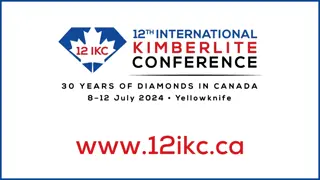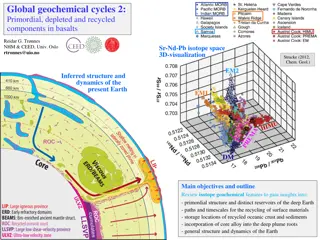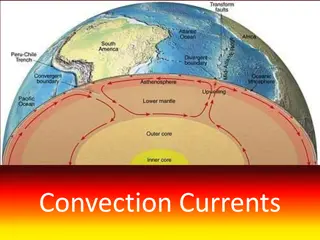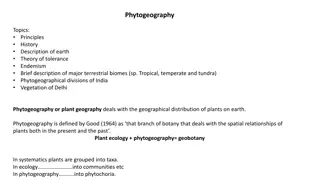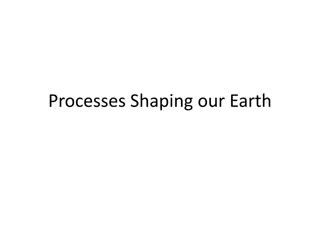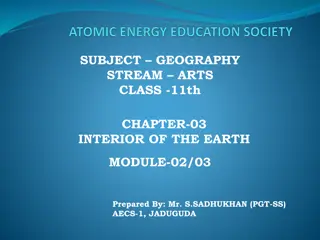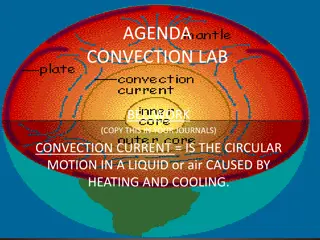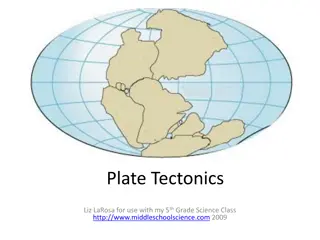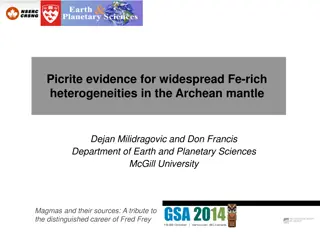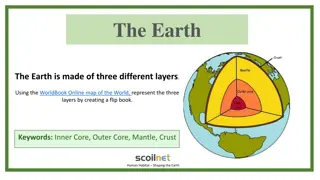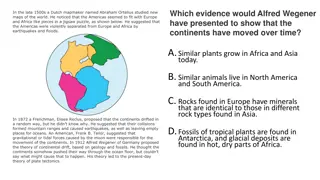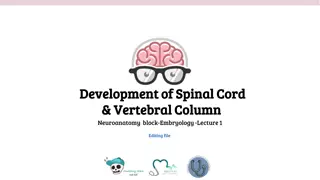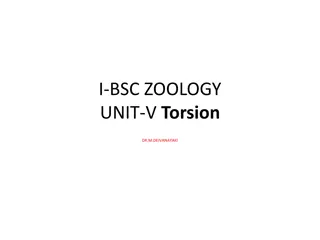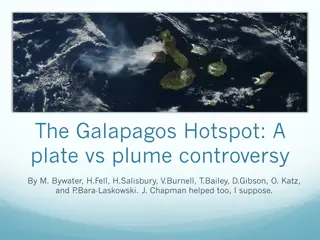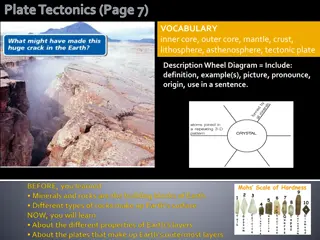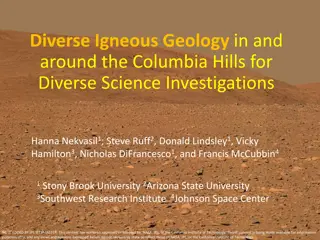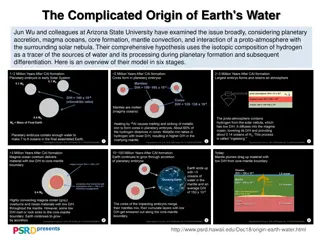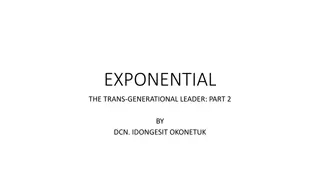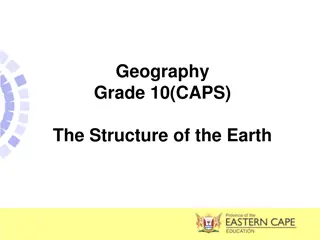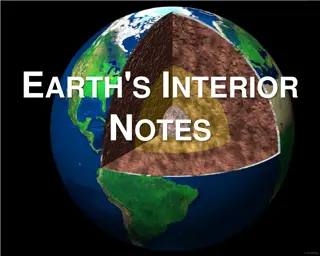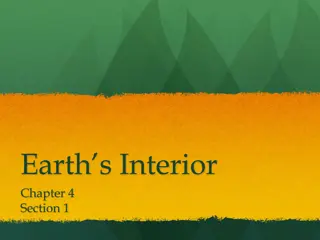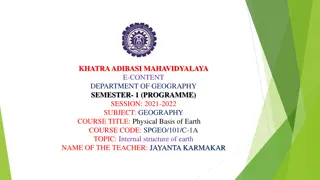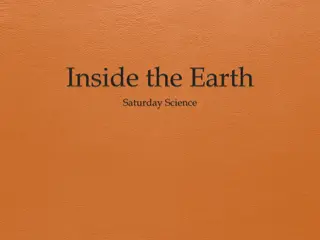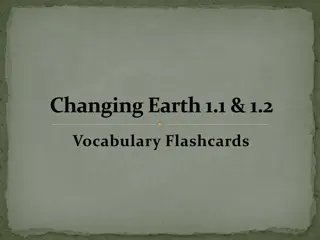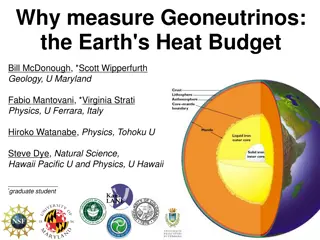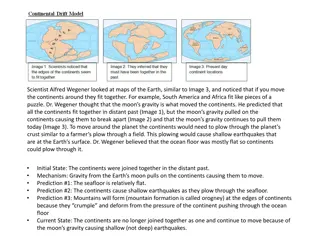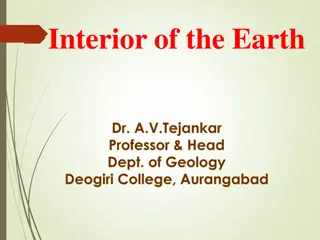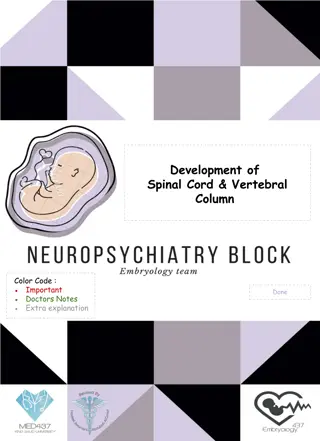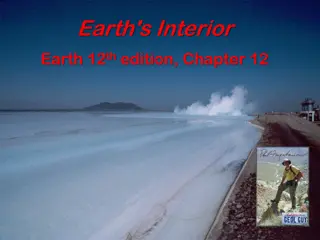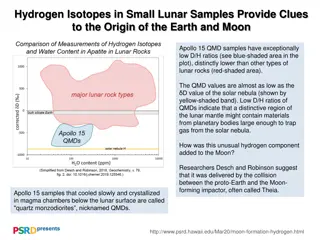Understanding Terrestrial Planets and Core Dynamics
Exploring the core-mantle interaction from the early Hadean period to present times reveals intriguing questions about the outer core's electrical conductivity, geodynamo sustainability, and inner core characteristics. Studies indicate challenges in maintaining the geodynamo, potential heat sources
9 views • 48 slides
Insights from the International Kimberlite Conference on Diamonds and Geology
Delve into the world of diamond mining and geology with a focus on Kimberlites. Explore topics such as diamond deposits exploration, mantle petrology, and economic geology presented by experts in the field. Discover the origins and evolution of Kimberlites, advancements in prospecting techniques, an
6 views • 8 slides
Insights into Earth's Geochemical Cycles and Isotopic Evolution
Explore the primordial, depleted, and recycled components in basalts to understand deep Earth reservoirs, recycling paths, and core-mantle dynamics using isotope geochemistry. Learn about radioactive decay systems, mantle array evolution, and U-Th-Pb systematics in planetary differentiation.
6 views • 30 slides
Understanding Convection Currents in Earth's Systems
Convection currents refer to the movement of heat by fluids like liquids and gases, transferring heat from one place to another. They play a significant role in the geosphere, atmosphere, and hydrosphere of the Earth, influencing phenomena such as plate tectonics, winds, and ocean currents. In the g
0 views • 12 slides
Respiration in Mollusca: Adaptations to Different Habitats
Mollusca exhibit various modes of respiration depending on their habitat - aquatic, terrestrial, or amphibious. Different respiratory organs are modified accordingly, such as ctenidia or gills for aquatic species, pulmonary sac for aerial species, and mantle or integument for those lacking specific
0 views • 17 slides
Understanding Phytogeography: Geographical Distribution of Plants
Phytogeography, the branch of botany dealing with plant distribution, encompasses principles, history, major biomes, and India's divisions. It explores phytochoria, natural floristic areas based on species distribution. The study's history dates back to Theophrastus and Linnaeus, with Humboldt and H
0 views • 7 slides
Understanding Processes Shaping Earth: Lithosphere, Plate Tectonics, and Effects
Explore the components of our planet, such as the lithosphere, hydrosphere, atmosphere, and biosphere. Learn how the lithosphere, consisting of the Earth's crust and top solid mantle, interacts through plate tectonics, causing movements that shape the Earth's surface. Discover the concept of Pangaea
0 views • 31 slides
Journey to the Center of the Earth: A Geographical Exploration
Delve into the intricate layers of the Earth's interior, from the solid crust to the molten mantle and the metallic core. Explore the composition, thickness, and characteristics of each layer, revealing the fascinating mysteries beneath our feet.
0 views • 13 slides
Explore Convection Currents Lab Activity
Engage students in a hands-on lab activity to observe convection currents in action. The agenda includes bell work about convection, a hypothesis on confetti paper movement in hot water, detailed lab procedures, drawing conclusions with CER format, and thought-provoking conclusion questions related
0 views • 7 slides
Helium Abundance Variations in MORB vs OIB Geochemistry
In the study of helium abundances in Mid-Ocean Ridge Basalts (MORB) and Ocean Island Basalts (OIB), it is found that degassed MORB has higher concentrations of 3He compared to OIB. Various models and scenarios explain the differences in 3He/4He ratios in different geological settings, such as carbon
1 views • 14 slides
Exploring Plate Tectonics and Earth's Structure for 5th Grade Science
Delve into the world of plate tectonics with a focus on Earth's layers, crust, mantle, and core. Understand how tectonic plates move and learn about continental drift and the concept of Pangea. Explore evidence of Pangea, sea floor spreading, and the fascinating geological processes that shape our p
0 views • 23 slides
Picrite Evidence for Fe-Rich Heterogeneities in Archean Mantle
Terrestrial basalts generally have low FeO content, but Archean mafic/ultramafic rocks show high FeO levels inconsistent with typical sources. Neoarchean Fe-rich magmatism is observed, with ferropicrites displaying unique geochemical characteristics. This study explores the widespread presence of Fe
0 views • 17 slides
Exploring the Layers of the Earth and Plate Movement
Dive into the composition of the Earth through its layers - Crust, Mantle, Outer Core, and Inner Core. Understand how plate movement affects the Earth's surface and human habitat. Interactive activities and group discussions enhance learning about the Earth's structure.
0 views • 15 slides
Understanding Earth's Structure and Continental Drift Theories
Dutch mapmaker Abraham Ortelius noted the jigsaw fit of continents, leading to the theory of continental drift. Alfred Wegener proposed the movement of continents based on geological evidence, influencing plate tectonics theory. Earth's layers vary from the thick mantle to the solid inner core due t
0 views • 27 slides
Embryology of Spinal Cord and Vertebral Column Development
Explore the fascinating embryological journey of the spinal cord and vertebral column development, covering topics such as neural tube formation, layers of the spinal cord, subdivisions of mantle and marginal zones, chondrification, ossification stages, spina bifida types, and more. Dive into the st
1 views • 15 slides
Understanding Torsion in Gastropods: Mechanism, Effects, and Significance
Torsion is a key developmental process in gastropods, involving the rotation of the visceral mass, mantle, and shell. This rotation has significant effects on the positioning of organs and overall physiology in gastropods. The process of torsion is crucial during larval development, providing advant
0 views • 6 slides
Debunking the Galapagos Hotspot: Plate vs. Plume Controversy
Situated in the Pacific Ocean, the Galapagos Islands have sparked a debate on whether they were formed by mantle plumes or the spreading ridge. Evidence refuting the plume theory includes variations in isotopic compositions, non-progressive volcanic activity, unique morphology, seismic findings, and
0 views • 9 slides
Earth's Layers and Plate Tectonics Overview
Earth's layers, including the core, mantle, and crust, have different properties and compositions that shape the planet's structure. Scientists study seismic waves to understand Earth's interior. Plate tectonics play a crucial role in shaping the planet's surface features through the movement of lit
0 views • 13 slides
Exploring Diverse Igneous Geology in and around the Columbia Hills
Studying the diverse igneous geology in and around the Columbia Hills provides insights into Martian atmosphere, volatile budget, age, source characteristics, cooling history, and more. Researchers have uncovered valuable information by coupling unaltered igneous rocks with meteorites and surface sp
0 views • 19 slides
The Complicated Formation of Earth's Water: A Detailed Overview
Jun Wu and colleagues at Arizona State University have developed a comprehensive model to explain the origin of Earth's water through stages such as planetary accretion, core formation, and interactions with the solar nebula. By tracing the isotopic composition of hydrogen, they explore how water so
0 views • 7 slides
Keys to Becoming a Trans-Generational Leader
Explore the attributes, rewards, and call for service of a trans-generational leader depicted in visual content, emphasizing the importance of equipping leaders for exponential growth and succession planning. Discover the relevance of teaching and the different age generations' role in leadership de
0 views • 8 slides
Exploring Earth's Structure and Continental Drift
Delve into the fascinating layers of the Earth, including the crust, mantle, and core, while understanding how rocks are classified and the processes of weathering, erosion, and rock formation. Discover the concept of continental drift through evidence such as fossil similarities and geological form
0 views • 10 slides
Discovering Earth's Layers and Structure
Explore the intriguing composition of Earth's interior, including the layers such as the crust, mantle, outer core, and inner core. Learn about tectonic plates, continental drift, and the concept of Pangaea. Delve into the depths of the Earth and understand the materials that make up each layer thro
0 views • 8 slides
Journey into Earth's Depths: Understanding its Layers and Composition
Delve into the inner workings of Earth through seismic waves and drilling samples, revealing a complex structure of layers such as the crust, mantle, outer core, and inner core. Explore the varying temperatures and pressures that shape our planet's composition.
0 views • 20 slides
Understanding Earth's Internal Structure: A Geographical Perspective
Deep parts of Earth's interior are studied indirectly through geophysics, including seismic waves, magnetic fields, gravity, and heat. Seismic studies reveal Earth's layers - crust, mantle, and core - each with distinct properties and compositions. The lithosphere, comprising the upper mantle and cr
0 views • 12 slides
Journey to the Earth's Layers
The Earth's structure consists of four main layers: the crust, mantle, outer core, and inner core. The crust is the thin, rocky layer we see on the surface, while the mantle is a solid layer that flows like a viscous liquid. The outer core is a hot, melted layer of iron and nickel, and the inner cor
0 views • 10 slides
Understanding Earth's Layers: Vocabulary Flashcards
Explore essential vocabulary related to Earth's structure through informative flashcards depicting key terms such as Inner Core, Mantle, Lithosphere, Tectonic Plate, Outer Core, and more. Enhance your knowledge of the planet's composition and geology.
0 views • 26 slides
Geoneutrinos and Earth's Thermal Power Budget Analysis
Geoneutrinos play a crucial role in understanding the Earth's heat budget. Researchers like Bill McDonough and others utilize geoneutrino studies to investigate radioactive decay driving the Earth's internal processes, mantle convection, plate tectonics, and more. By measuring geoneutrinos, valuable
0 views • 12 slides
The Theory of Continental Drift and Plate Tectonics
Scientist Alfred Wegener proposed the theory of continental drift, noticing how continents could fit together like pieces of a puzzle. His idea evolved into the concept of plate tectonics, explaining the movement of Earth's lithosphere. This model highlights the dynamic nature of the Earth's surface
0 views • 4 slides
Journey to the Center of the Earth: Unveiling the Layers
Delve into the depths of the Earth with Dr. A.V. Tejankar to explore the three main layers - Crust, Mantle, and Core. Discover how the Earth's composition and physical properties vary across these layers, resembling the layers of an egg. Uncover the secrets of the Earth's interior, from the thin but
0 views • 15 slides
Development of Spinal Cord and Vertebral Column - Doctors' Notes
The development of the spinal cord from the neural tube, layers of the spinal cord, subdivisions of mantle and marginal zones, meningeal layers, vertebral column development, chondrification, ossification stages, spina bifida types, and positional changes of the spinal cord are crucial aspects cover
0 views • 10 slides
Exploring Earth's Interior: Layers, Structure, and Seismic Waves
Explore the dynamic layers of Earth's interior, from its three major layers formed by gravity and chemical segregation to mineral and phase changes in the mantle. Discover how seismic waves provide insights into the planet's composition as they interact with different layers, reflecting and refracti
0 views • 50 slides
Vote for Your Favorite Baseball Stars from the 1960s
Get nostalgic and vote for your favorite baseball players from the 1960s! From legendary catchers to dominant pitchers and powerful hitters, relive the golden era of baseball with iconic players like Mickey Mantle, Hank Aaron, Sandy Koufax, and more. Choose your All-Star lineup from this star-studde
0 views • 11 slides
Unraveling the Origin of Earth and Moon through Hydrogen Isotopes in Small Lunar Samples
Exploring the D/H ratios in small lunar samples, researchers suggest a distinctive region in the lunar mantle might hold material from planetary bodies, impacting the Moon's hydrogen component. The Desch-Robinson model combines geochemical data and planet formation models to propose how the Moon for
0 views • 5 slides

